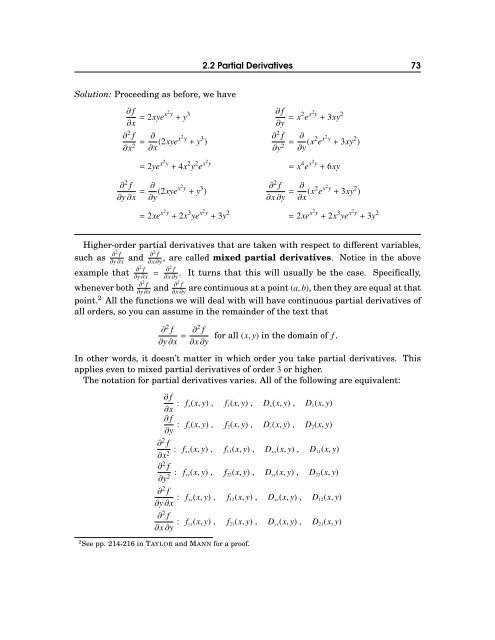Michael Corral: Vector Calculus
Michael Corral: Vector Calculus
Michael Corral: Vector Calculus
You also want an ePaper? Increase the reach of your titles
YUMPU automatically turns print PDFs into web optimized ePapers that Google loves.
2.2 Partial Derivatives 73<br />
Solution: Proceeding as before, we have<br />
∂f<br />
∂x = 2xyex2y +y 3<br />
∂ 2 f ∂<br />
∂x 2= ∂x (2xyex2y +y 3 )<br />
= 2ye x2y +4x 2 y 2 e x2 y<br />
∂ 2 f<br />
∂y∂x = ∂ ∂y (2xyex2y +y 3 )<br />
∂f<br />
∂y = x2 e x2y +3xy 2<br />
∂ 2 f ∂<br />
∂y 2= ∂y (x2 e x2y +3xy 2 )<br />
= x 4 e x2y +6xy<br />
∂ 2 f<br />
∂x∂y = ∂ ∂x (x2 e x2y +3xy 2 )<br />
= 2xe x2y +2x 3 ye x2y +3y 2 = 2xe x2y +2x 3 ye x2y +3y 2<br />
Higher-order partial derivatives that are taken with respect to different variables,<br />
such as ∂2 f<br />
∂y∂x and ∂2 f<br />
∂x∂y<br />
, are called mixed partial derivatives. Notice in the above<br />
example that ∂2 f<br />
∂y∂x = ∂2 f<br />
∂x∂y<br />
. It turns that this will usually be the case. Specifically,<br />
wheneverboth ∂2 f<br />
∂y∂x and ∂2 f<br />
∂x∂y arecontinuousatapoint(a,b),thentheyareequalatthat<br />
point. 2 All the functions we will deal with will have continuous partial derivatives of<br />
all orders, so you can assume in the remainder of the text that<br />
∂ 2 f<br />
∂y∂x = ∂2 f<br />
∂x∂y<br />
for all (x,y) in the domain of f.<br />
In other words, it doesn’t matter in which order you take partial derivatives. This<br />
applies even to mixed partial derivatives of order 3 or higher.<br />
The notation for partial derivatives varies. All of the following are equivalent:<br />
∂f<br />
∂x : f x(x,y), f 1 (x,y), D x (x,y), D 1 (x,y)<br />
∂f<br />
∂y : f y(x,y), f 2 (x,y), D y (x,y), D 2 (x,y)<br />
∂ 2 f<br />
∂x 2 : f xx(x,y), f 11 (x,y), D xx (x,y), D 11 (x,y)<br />
∂ 2 f<br />
∂y 2 : f yy(x,y), f 22 (x,y), D yy (x,y), D 22 (x,y)<br />
∂ 2 f<br />
∂y∂x : f xy(x,y), f 12 (x,y), D xy (x,y), D 12 (x,y)<br />
∂ 2 f<br />
∂x∂y : f yx(x,y), f 21 (x,y), D yx (x,y), D 21 (x,y)<br />
2 See pp. 214-216 in TAYLOR and MANN for a proof.








